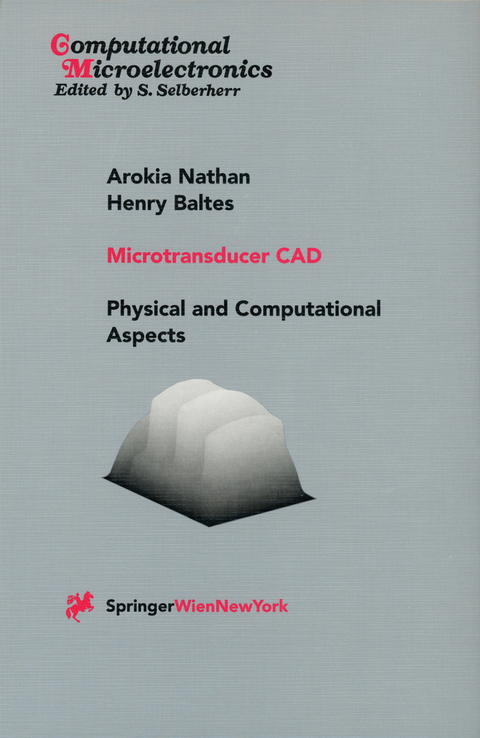
Microtransducer CAD
Springer Wien (Verlag)
978-3-7091-7321-3 (ISBN)
Henry Baltes is Professor Emeritus of ETH Zurich affiliated with Micro and Nanosystems at the Department of Mechanical and Process Engineering. He was Professor of Physical Electronics at ETH Zurich and Director of the Physical Electronics Laboratory (PEL) from 1988 to 2006. In 2004 and 2005 he acted as start-up Chair of the future Department of Biosystems Science and Engineering (D-BSSE) of ETH Zurich located at Basel. Henry Baltes is a Fellow of the IEEE and a Member of the Swiss Academy of Technical Sciences. He served on the Editorial Board of the Proceedings of the IEEE, the Search Committee of the Koerber Foundation, and the Advisory Committee of the Freiburg Institute of Advanced Sudies. He is a co-founder of the spin-off company SENSIRION.
1. Introduction.- 1.1 Modeling and Simulation of Microtransducers.- 1.2 Illustrative Example.- 1.3 Progress in Microtransducer Modeling.- 1.4 References.- 2 Basic Electronic Transport.- 2.1 Poisson's Equation.- 2.2 Continuity Equations.- 2.3 Carrier Transport in Crystalline Materials and Isothermal Behavior.- 2.4 Electrical Conductivity and Isothermal Behavior in Polycrystalline Materials.- 2.5 Electrical Conductivity and Isothermal Behavior in Metals.- 2.6 Boundary and Interface Conditions.- 2.7 The External Fields - What Do They Influence?.- 2.8 References.- 3 Radiation Effects on Carrier Transport.- 3.1 Reflection and Transmission of Optical Signals.- 3.2 Modeling Optical Absorption in Intrinsic Semiconductors.- 3.3 Absorption in Heavily-Doped Semiconductors.- 3.4 Optical Generation Rate and Quantum Efficiency.- 3.5 Low Energy Interactions with Insulators and Metals.- 3.6 High Energy Interactions and Monte Carlo Simulations.- 3.7 Model Equations for Radiant Sensor Simulation.- 3.8 Illustrative Simulation Example - Color Sensor.- 3.9 References.- 4 Magnetic Field Effects on Carrier Transport.- 4.1 Galvanomagnetic Transport Equation.- 4.2 Galvanomagnetic Transport Coefficients.- 4.3 Equations and Boundary Conditions for Magnetic Sensor Simulation.- 4.4 Illustrative Simulation Example - Micromachined Magnetic Vector Probe.- 4.5 References.- 5 Thermal Non-Uniformity Effects on Carrier Transport.- 5.1 Non-Isothermal Effects.- 5.2 Electrothermal Transport Model.- 5.3 Electrical and Thermal Transport Coefficients.- 5.4 Electro-Thermo-Magnetic Interactions.- 5.5 Heat Transfer in Thermal Microstructures.- 5.6 Summary of Equations and Computational Procedure.- 5.7 Illustrative Simulation Example - Micro Pirani Gauge.- 5.8 References.- 6 Mechanical Effects on CarrierTransport.- 6.1 Piezoresistive Effect.- 6.2 Strain and Electron Transport.- 6.3 Strain and Hole Transport.- 6.4 Piezojunction Effect.- 6.5 Effects of Stress Gradients.- 6.6 Galvano-Piezo-Magnetic Effects.- 6.7 The Piezo Drift-Diffusion Transport Model.- 6.8 Illustrative Simulation Example - Stress Effects on Hall Sensors.- 6.9 References.- 7 Mechanical and Fluidic Signals.- 7.1 Definitions.- 7.2 Model Equations for Mechanical Analysis.- 7.3 Model Equations for Analysis of Fluid Transport.- 7.4 Illustrative Simulation Example - Analysis of Flow Channels.- 7.5 References.- 8 Micro-Actuation.- 8.1 Transduction Principles.- 8.2 State-of-the-Art and Preview.- 8.3 Electrostatic Actuation.- 8.4 Thermal Actuation.- 8.5 Magnetic Actuation.- 8.6 Piezoelectric Actuation.- 8.7 Electroacoustic Transducers.- 8.8 Computational Procedure and Coupling.- 8.9 Illustrative Example - CMOS Micromirror.- 8.10 References.- 9 Microsystem Simulation.- 9.1 Electrical Analogues for Mixed-Signals and Historical Developments.- 9.2 Circuit Modeling and Implementation Considerations.- 9.3 Lumped Analysis: Illustrative Example - Electrostatic Micromirror.- 9.4 Distributed Analysis: Illustrative Example - Flow Microsensor.- 9.5 References.
| Erscheint lt. Verlag | 3.10.2013 |
|---|---|
| Reihe/Serie | Computational Microelectronics |
| Zusatzinfo | XVIII, 427 p. 44 illus. |
| Verlagsort | Vienna |
| Sprache | englisch |
| Maße | 155 x 235 mm |
| Gewicht | 685 g |
| Themenwelt | Technik ► Elektrotechnik / Energietechnik |
| Schlagworte | Circuit • Computer-Aided Design (CAD) • Electrical Engineering • Integrated circuit • Integrated Circuits • Material • Microactuators • Microsensors • Microstructures • microsystems • Model • Modeling • Monte Carlo • Monte Carlo simulation • semiconductor • Sensor • Simulation • Standard |
| ISBN-10 | 3-7091-7321-3 / 3709173213 |
| ISBN-13 | 978-3-7091-7321-3 / 9783709173213 |
| Zustand | Neuware |
| Haben Sie eine Frage zum Produkt? |
aus dem Bereich


